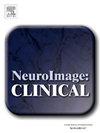The effects of traumatic brain Injury, post-traumatic stress disorder on Amyloid-β associated network hyperconnectivity and progression of gray matter atrophy
IF 3.6
2区 医学
Q2 NEUROIMAGING
引用次数: 0
Abstract
Background
Amyloid-β associated network hypersynchrony is an early manifestation of pre-clinical Alzheimer’s Disease (AD). The overall goal was to investigate a. how TBI and PTSD influence hypersynchrony expression and b. how progressing gray matter atrophy affects hypersynchrony expression.
Methods
T1-weighted images, resting-state fMRIs and amyloid-β SUVRs were obtained from 234 DoD-ADNI subjects with or without TBI and/or PTSD. The denoised BOLD signal from 382 rois was extracted with CONN and dynamic resting state analysis was used to identify 8 states including one corresponding to a hypersynchrony state (HSS). SuStaIn with gray matter volumes and amyloid-β SUVR as inputs was used to identify 2 subtypes with progressive gray matter loss.
Results
HSS dwell-time correlated positively with amyloid-β (Kendall tau = 0.125,p = 0.047) and tau Braak stage 5&6 SUVR (Kendall tau = 0.200,p = 0.035). TBI increased the likelihood to observe the HSS (81 % with vs. 18 % wo TBI p < 0.001) as did a diagnosis of PTSD (67.4 % with vs. 32.6 % wo PTSD, p = 0.003). The SuStaIn subtypes differed mostly by the timing of the amyloid-β build-up but not by atrophy pattern. Subtype 2 had higher amyloid-β loads and longer HSS dwell-times than subtype 1 that had higher CAPS scores than subtype 2. Gray matter atrophy did not influence HSS dwell-time.
Conclusion
TBI and PTSD increased the likelihood to observe HSS. HSS dwell time was determined by AD pathology severity. The subtype characteristics indicate that PTSD drives gray matter loss in subtype 1 and AD pathology that in subtype 2. Severity of gray matter atrophy influenced neither HSS occurrence nor intensity.
创伤性脑损伤、创伤后应激障碍对淀粉样蛋白-β相关网络超连通性和灰质萎缩进展的影响
damyloid -β相关网络高同步是临床前阿尔茨海默病(AD)的早期表现。总的目标是研究a.创伤性脑损伤和创伤后应激障碍如何影响超同步性表达,b.进展性灰质萎缩如何影响超同步性表达。方法获取234例伴有或不伴有TBI和/或PTSD的DoD-ADNI受试者的st1加权图像、静息状态fmri和β淀粉样蛋白SUVRs。利用CONN提取382个样本的去噪BOLD信号,并利用动态静息状态分析识别出8种状态,其中1种状态对应于超同步状态(HSS)。用灰质体积和淀粉样蛋白-β SUVR作为输入来识别2种进行性灰质损失亚型。结果shss存活时间与淀粉样蛋白-β (Kendall tau = 0.125,p = 0.047)、tau Braak期5、6期SUVR (Kendall tau = 0.200,p = 0.035)呈正相关。TBI增加了观察HSS的可能性(81% vs. 18%;0.001),诊断为创伤后应激障碍(67.4%对32.6%,p = 0.003)。SuStaIn亚型的差异主要在于淀粉样蛋白-β形成的时间,而不是萎缩模式。亚型2比亚型1具有更高的淀粉样蛋白-β负荷和更长的HSS停留时间,而亚型1的CAPS评分高于亚型2。灰质萎缩不影响HSS停留时间。结论创伤后应激障碍和创伤后应激障碍增加了HSS发生的可能性。HSS停留时间由AD病理严重程度决定。亚型特征表明PTSD在亚型1中导致灰质损失,而在亚型2中导致AD病理。灰质萎缩的严重程度既不影响HSS的发生也不影响HSS的强度。
本文章由计算机程序翻译,如有差异,请以英文原文为准。
求助全文
约1分钟内获得全文
求助全文
来源期刊

Neuroimage-Clinical
NEUROIMAGING-
CiteScore
7.50
自引率
4.80%
发文量
368
审稿时长
52 days
期刊介绍:
NeuroImage: Clinical, a journal of diseases, disorders and syndromes involving the Nervous System, provides a vehicle for communicating important advances in the study of abnormal structure-function relationships of the human nervous system based on imaging.
The focus of NeuroImage: Clinical is on defining changes to the brain associated with primary neurologic and psychiatric diseases and disorders of the nervous system as well as behavioral syndromes and developmental conditions. The main criterion for judging papers is the extent of scientific advancement in the understanding of the pathophysiologic mechanisms of diseases and disorders, in identification of functional models that link clinical signs and symptoms with brain function and in the creation of image based tools applicable to a broad range of clinical needs including diagnosis, monitoring and tracking of illness, predicting therapeutic response and development of new treatments. Papers dealing with structure and function in animal models will also be considered if they reveal mechanisms that can be readily translated to human conditions.
 求助内容:
求助内容: 应助结果提醒方式:
应助结果提醒方式:


